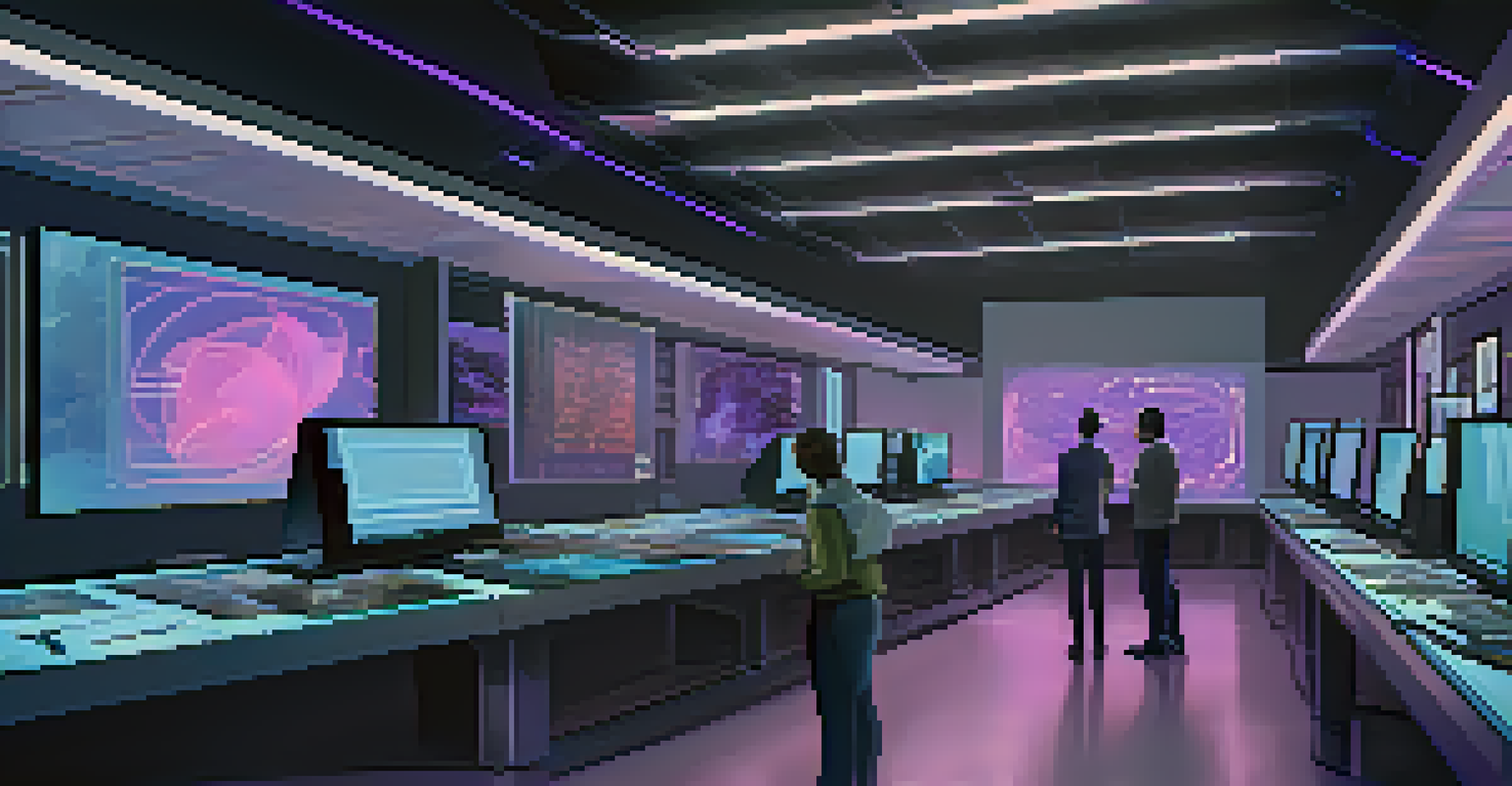The Role of Technology in Preserving Digital Art Forms

Understanding Digital Art and Its Challenges
Digital art encompasses a wide range of creative expressions, from digital paintings to interactive installations. Unlike traditional art forms, digital art faces unique challenges, such as file corruption, software obsolescence, and changing technology standards. These challenges can threaten the longevity of digital works, making preservation a critical concern for artists and collectors alike.
Digital art is like a window into the future, but if we don’t preserve it, that window may one day close.
As technology evolves, so too do the platforms and tools used to create and display digital art. This constant change can render older works inaccessible if not properly preserved. Imagine trying to view a classic movie on a modern device without the right format; similarly, digital art can become lost in translation without adequate care.
In understanding these challenges, we can better appreciate the role technology plays in preserving digital art. It’s not just about saving files; it’s about ensuring that future generations can experience these unique creations in their intended form.
The Importance of Archiving Digital Art
Archiving digital art is akin to creating a time capsule that captures the essence of an era’s creativity. It involves not only saving files but also documenting the context in which they were created, including the technology used and the artist's intent. This deeper layer of preservation ensures that digital artworks retain their significance over time.

Organizations and institutions are stepping up to create dedicated digital art archives. These repositories not only store files but also offer access to the public, allowing a wider audience to appreciate and study these works. Think of it like a museum for digital art, where visitors can explore and engage with pieces that might otherwise be forgotten.
Digital Art Faces Unique Challenges
Digital art's preservation is threatened by issues like file corruption and changing technology standards.
Effective archiving also involves using various formats and redundancy strategies to mitigate the risk of data loss. By diversifying storage methods and regularly updating formats, archivists can safeguard these artworks from the threat of technological obsolescence.
Technology's Role in Restoration of Digital Art
Restoration in the digital art world often involves using technology to repair or recover damaged files. This can include recovering lost data, fixing corrupted images, or even recreating missing elements of a piece. Just as conservators restore a traditional painting, digital art restorers employ software tools to breathe new life into compromised works.
Art is not what you see, but what you make others see.
One fascinating aspect of digital art restoration is the use of artificial intelligence (AI) to analyze and reconstruct artworks. AI can help predict what a piece might have looked like if certain elements were lost, providing a glimpse into the artist's original vision. It's like piecing together a puzzle, where technology aids in filling in the gaps.
This intersection of art and technology showcases how modern tools can enhance, rather than detract from, the creative process. By embracing these advancements, artists can ensure their work remains vibrant and true to its original form, even as time takes its toll.
Innovative Platforms for Digital Art Preservation
With the rise of the internet, innovative platforms have emerged to support digital art preservation. Websites and online galleries provide a space for artists to showcase their work while ensuring it remains accessible to future audiences. Think of these platforms as digital museums, where art can be enjoyed without the constraints of physical space.
Additionally, blockchain technology is gaining traction as a means of preserving digital art. By creating a secure, verifiable ledger of ownership and authenticity, artists can protect their work from unauthorized replication. This digital fingerprint not only preserves the art itself but also the artist's rights.
Archiving is Essential for Longevity
Effective archiving captures not just the artwork but also its context, ensuring its significance endures over time.
As these platforms evolve, they continue to shape the future of digital art preservation. They offer new opportunities for artists to connect with their audience while safeguarding their creations for generations to come.
Collaborative Efforts in Digital Art Preservation
Collaboration among artists, technologists, and institutions is key to effective digital art preservation. By working together, these stakeholders can share best practices, resources, and expertise to create a comprehensive preservation strategy. It's a bit like a team sport, where each player brings their unique skills to the table.
Many organizations are now forming partnerships to address the challenges of preserving digital art. For instance, museums may collaborate with tech companies to develop innovative solutions for archiving and restoration. These partnerships not only enhance preservation efforts but also foster a richer cultural dialogue around digital art.
Through collaboration, the digital art community can ensure that diverse voices and perspectives are represented in preservation efforts. This collective approach strengthens the cultural fabric of our society, allowing future generations to appreciate a wide array of digital expressions.
Education and Awareness in Digital Art Preservation
Education plays a pivotal role in raising awareness about the importance of digital art preservation. By informing artists, collectors, and the general public about the unique challenges facing digital works, we can foster a culture of care and responsibility. It’s much like teaching someone to appreciate a fine wine; understanding its complexities enhances the experience.
Workshops, seminars, and online courses are becoming more prevalent, providing resources for those interested in preserving digital art. These educational initiatives help equip individuals with the knowledge and skills needed to navigate the ever-changing landscape of technology and art. They empower creators to take control of their work’s longevity.
Collaborative Efforts Enhance Preservation
Collaboration among artists, technologists, and institutions is crucial for developing comprehensive digital art preservation strategies.
As awareness grows, more people are likely to engage in preservation efforts, ensuring that digital art continues to thrive. This grassroots movement can lead to significant changes in how we view and protect digital creativity for the future.
The Future of Digital Art Preservation
Looking ahead, the future of digital art preservation is bright, thanks to ongoing advancements in technology. Emerging tools and methods promise to enhance our ability to safeguard these unique creations, making it easier to archive, restore, and share them. It's an exciting time for the digital art community, with endless possibilities on the horizon.
As more artists embrace digital mediums, the need for effective preservation strategies will only increase. By prioritizing preservation now, we can ensure that the rich tapestry of digital creativity remains intact for future generations. It's a proactive approach, much like planting seeds today to cultivate a flourishing garden tomorrow.

Ultimately, the role of technology in preserving digital art forms is vital. By harnessing the power of innovation, collaboration, and education, we can create a sustainable future for digital creativity, celebrating the unique expressions of artists around the world.